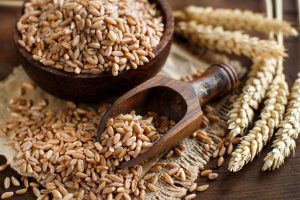Written by: Dr. Jacquie Jacob, University of Kentucky
Spelt (Triticum spelta L.), considered an ancient wheat species, shows a higher resistance to environmental influences than common wheat. Spelt does not require as much intensive cultivation, pesticide application, or fertilizer as is necessary when growing other wheats. Spelt is grown on a limited scale as a fall-sown crop in Western Europe. Spring spelt was investigated as a potential crop for western Canada and was found to produce a grain yield similar to that of common wheat.

The nutrient levels, as well as the antinutritional factors, in spelt wheat are similar to those of conventional wheat. The retention of the hulls on the grain at harvest has limited the use of spelt. There is very little research on the use of spelt grain in animal feeds. Early studies indicated that spelt could replace corn in chick or poult diets with no significant differences in growth. Feed efficiency, however, was reduced. The addition of fat to the diet improved feed conversion, suggesting that the energy value assigned to spelt when formulating the diets was higher than the actual value.

